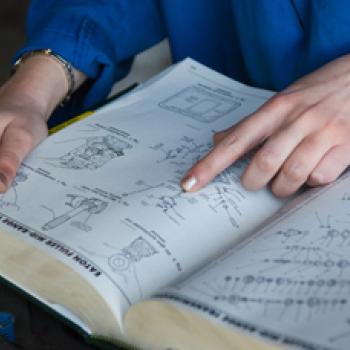Our Classroom: Writing an Owner's Manual

- Preview |
- Standards |
- Resources & Preparation |
- Instructional Plan |
- Related Resources |
- Comments
Overview
There are many back to school activities that take place to help create classroom community. It is important for students to feel that they own the space and the learning that takes place in their classroom. Foster such ownership for students by collaboratively writing an owner's manual that describes the classroom's areas and procedures. Students begin by sharing thoughts and feelings about school so far and brainstorming a list of important classroom places, routines, and events. Next, they select an item from the brainstormed list and write a draft description of how their topic “works” in the classroom and after peer-review, make appropriate revisions. Then students use interactive tools to create their piece of the classroom owner's manual. Finally, students share their work and decide as a class how to share the information with others, such as at Open House or when new students join the classroom.
Featured Resources
Comic Creator: Students can use this online tool allows to depict classroom places and activities.
Flip Book: This online tool allows students to create up to 10 pages of text and images describing classroom jobs and learning centers.
Printing Press: Students can use this online tool to create a newspaper, brochure, booklet, or flyer. Students choose a layout, add content, and then print out their work.
From Theory to Practice
Creating classroom community is crucial at the beginning of the school year. As Mary Waskow explains, students "must see the need for helping one another and working together. They also need an environment in which they feel free to take risks in order to become autonomous. The classroom is not mine exclusively; rather, it is our classroom" (26). This lesson provides a way for students and teachers to work together to create such community in their classroom while also taking ownership for their room.
Further Reading
Common Core Standards
This resource has been aligned to the Common Core State Standards for states in which they have been adopted. If a state does not appear in the drop-down, CCSS alignments are forthcoming.
State Standards
This lesson has been aligned to standards in the following states. If a state does not appear in the drop-down, standard alignments are not currently available for that state.
NCTE/IRA National Standards for the English Language Arts
- 4. Students adjust their use of spoken, written, and visual language (e.g., conventions, style, vocabulary) to communicate effectively with a variety of audiences and for different purposes.
- 5. Students employ a wide range of strategies as they write and use different writing process elements appropriately to communicate with different audiences for a variety of purposes.
- 6. Students apply knowledge of language structure, language conventions (e.g., spelling and punctuation), media techniques, figurative language, and genre to create, critique, and discuss print and nonprint texts.
- 11. Students participate as knowledgeable, reflective, creative, and critical members of a variety of literacy communities.
- 12. Students use spoken, written, and visual language to accomplish their own purposes (e.g., for learning, enjoyment, persuasion, and the exchange of information).
Printouts
Websites
Preparation
- Make appropriate number of copies of the Peer Review Form and the Classroom Owner's Manual Self-Assessment.
- Locate an owner's manual or guide to share with the class as an example. Guides are widely available online, including at the following locations:
- Make an overhead transparency or enlarge the student example of an owner's manual entry.
- Decide which of the publishing options to use with the class. Test the tools that you've chosen (e.g., Comic Creator, Flip Book, Multigenre Mapper, Letter Generator, Stapleless Book, and/or ReadWriteThink Printing Press) on your computers to familiarize yourself with the tools and ensure that you have the Flash plug-in installed. You can download the plug-in from the technical support page.
Student Objectives
Students will
- brainstorm places, routines, and people associated with their classroom.
- write and publish an expository piece about a component of their classroom.
- meet in peer-editing groups and provide feedback.
- assess their own writing using a checklist.
Session One
- Gather the students together in a group setting.
- Ask them to share some of their thoughts and feelings about school so far this year.
- After students have shared, have them pretend that they are new students joining the class or a family member visiting.
- What would be important for this new person to know?
- What people, places, routines are important?
- What is important for these new people to see and understand?
- What would be important for this new person to know?
- As the students brainstorm, record their thoughts on the board. Keep brainstorming until there is a substantial list of locations and experiences.
- Explain to the students that they will write an owner's manual for their classroom to help visitors and new students understand the classroom and its procedures.
- Ask students to share their experiences and knowledge of manuals.
- Share some examples of owner's manuals. Use manuals you have brought from home or online examples (for example, Kodak has owner's manuals for digital cameras online).
- When students have had a chance to explore at least one owner's manual, ask some questions to get them thinking about the type of writing involved. Use the following prompts to get discussion started:
- What is included in them?
- How is the text written?
- Are the descriptions long and written in paragraphs? Are there bulleted lists?
- What is included in them?
- Revisit the brainstormed list again. Have each student choose a favorite classroom event, routine, or place.
- Once students have selected their topic, invite them to write a draft descriptions of how their topic "works" in the classroom.
- If desired, share with the students an example of a piece from a classroom owner's manual.
Session Two
- Once students have written their draft descriptions about their component of the classroom, pass out copies of the Peer Review Forms.
- Arrange students in pairs or implement your usual peer review groups.
- Ask partners or groups to exchange and read one another's drafts. After reading the drafts, have them fill out the Peer Review Forms to provide feedback.
- After students have share and received feedback, allow time for the students to revise their piece of the owner's manual.
- When the students' descriptions have been revised, explain the publishing options to the students:
- Using the Comic Creator, students draw an activity or place in the classroom. Use conversation bubbles for the text.
- The Flip Book tool can be used by a group of students. Since students can add up to ten pages, groups can work together to write and draw about all of the learning centers, or describe each of the classroom jobs.
- Using the Multigenre Mapper, students can draw a picture and add up to three boxes of text for their section of the classroom owner's manual.
- The Letter Generator can be used to type of the descriptions of the classroom, and addressed to "Classroom Visitors."
- Using the Stapleless Book, several students can work together to create up to eight pages of their owner's manual.
- The Printing Press provides students with several publishing options. They can create a brochure, a flyer, a newsletter, or a booklet.
- Using the Comic Creator, students draw an activity or place in the classroom. Use conversation bubbles for the text.
- Allow students the rest of the session to work on their drafts and their plans for publishing the owner's manual.
Session Three
- Remind students of the publishing options, and answer any questions.
- If appropriate, distribute any special supplies students can use on the project, such as markers to color in drawings.
- Remind students that they will share their portion of the manual with the rest of the class during the next session.
- Allow students the rest of the session to work on publishing their piece of the classroom owner's manual.
Session Four
- Allow a few minutes at the beginning of the session for students to make any last-minute changes.
- Once students are ready, allow time for the students to share their section with the class.
- When all of the students have shared their piece of the manual, decide as a class how to share the information with others.
- Will the pieces of writing be displayed in the appropriate place in the classroom? For example, will the piece about writing portfolios be near the Writing Center?
- Will all of the published pieces be bound in a book for people to look at?
- Will the pieces of writing be displayed in the appropriate place in the classroom? For example, will the piece about writing portfolios be near the Writing Center?
- Invite the students to assess their work on the Classroom Owner's Manual Project, using the self-assessment checklist.
Extensions
- As the year progresses, review the manual periodically as a class and make any update or revisions that are needed. At the end of the school year, students might make a final revision of the manual to leave behind for the next class.
- Students can work together to create a map of the classroom and label the different locations. In their sections of the manual, they can indicate where on the map their topic is found.
- Working together, students can create a class newsletter, informing others about what is happening in their classroom. Use the ReadWriteThink lesson Creating a Classroom Newspaper, if desired.
- Students can branch out and write a manual for the entire school, describing common areas (e.g., cafeteria, gymnasium, and bathrooms) as well as school routines (e.g., announcement, dismissal, and assemblies).
-
Visit these Websites for additional back to school lessons, activities, and resources:
- Back to School Teaching Resource Collection: This NCTE resource provides additional lesson plans, teaching strategies, journal articles, and related resources to help the first weeks in the classroom flow more smoothly.
- Get Ready to Go Back to School!: On the ReadWriteThink Literacy Calendar, teachers and students can find lesson plans, Web resources, and texts to use while planning back to school activities.
- Back to School Booklist: This booklist suggests titles to use with students K-5 on a back to school theme.
- Back to School Teaching Resource Collection: This NCTE resource provides additional lesson plans, teaching strategies, journal articles, and related resources to help the first weeks in the classroom flow more smoothly.
Student Assessment / Reflections
A great deal about the students’ understanding can be gained from listening to the students as they discuss the classroom and its routines and places of interest.
In addition, kidwatching is another good assessment for this activity. Circulate throughout the room while the students are meeting in their peer review groups. Listen to their comments and observe their interactions. Take note of the feedback they provide to each other, using their Peer Review Forms.
Finally, use the students’ self-assessment papers to guide your instruction with further writing projects.

Add new comment